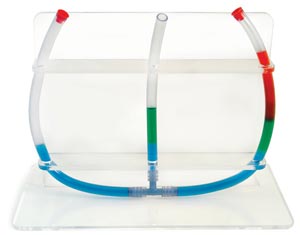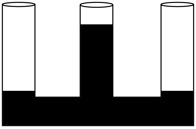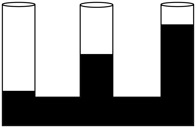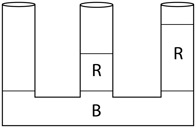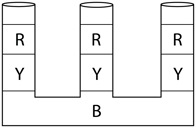 by: Tami O’Connor
by: Tami O’Connor
The W-Tube is a device that was invented and developed by Ron Perkins, Chemistry and Physics high school teacher for 33 years and founder of Educational Innovations. This amazing teaching tool was designed to have students in every grade level, kindergarten through high school, discover and gain a deeper understanding of concepts relating to density and air pressure.
In order to solve each puzzle, students need to have a basic understanding of density and air pressure. Depending upon the grade level of your students, you may want to conduct a few experiments or demonstrations prior to having them attempt the W-Tube challenges on their own. The following two activities do not utilize the W-Tube, however they will provide some younger students with the background knowledge necessary to successfully complete the W-Tube challenges.
This first activity is a valuable demonstration that shows that air takes up space. Start by balling up a paper towel or tissue and affixing it to the bottom of a plastic cup using two-sided tape. Invert the cup with the tissue inside and then  push the plastic cup into a clear container of water so the cup is completely submerged. Your students should be able to see that, although the air is somewhat compressed within the cup, the paper at the “top” of the cup remains dry.
push the plastic cup into a clear container of water so the cup is completely submerged. Your students should be able to see that, although the air is somewhat compressed within the cup, the paper at the “top” of the cup remains dry.
The second activity deals more with density, or how tightly packed the molecules are in a given object. An object’s density is determined by comparing its mass to its volume. For example, if you have two objects of the same size, the heavier object is said to be more dense.
Pour equal amounts of corn syrup, water and vegetable oil, into 3 different but identical beakers, and, using a balance, find the mass of each liquid. Then, gently pour the liquid with the second heaviest mass into the beaker with the liquid with the greatest mass. Finally, add the third liquid, which has the least amount of mass, to the beaker. The three liquids should remain neatly layered according to their density, indicating that the less dense liquid floats on the liquid that is more dense. This activity can also be conducted using different colored water with varying amounts of sugar in each, which would change the liquid’s density.
The W-Tube Puzzle is an excellent addition for any science table and is also great to use with students working in small groups. The apparatus (DEN-510) contains three connected tubes that form a W. The central t-connector between the three tubes allows water and air to move through freely. Because air and water each take up space, by capping one or more of the tubes, you can trap the air and/or water such that they are no longer able to flow freely. This gives the student the ability to vary the amount of water and air in each individual tube.
W-Tube Activity 1 – Air Pressure
Students, working in small groups, should use pipets to fill the W-Tube with colored water in order to replicate the following diagrams. Students should check with the teacher before emptying the W-Tube and moving on to the next diagram. By strategically placing a cap on specific tubes, one can trap water and/or air to fill the each tube at a different level. See the diagrams below. The challenges become increasingly more difficult as you move down the list. If a group of students complete their challenges quickly, ask them to replicate Challenge #3 using only one cap. It can be done, but it is more challenging!
W-Tube Activity 2 – Density
Provide each group of students with a beaker of sugar, food coloring (red, blue, and yellow), 3 small cups, a pipet, a spoon for measuring and mixing, and a source of water. Using the W-Tube (and the caps needed), students should alter the amount of sugar in each cup of colored water to replicate the picture provided. For example, since the diagram shows the blue water as the bottom layer, it is the denser liquid (and has the most sugar). Encourage your students to use as few caps as possible to complete each challenge. Students must keep the W-Tube apparatus firmly on the table at all times during the activity (no tipping except to empty between trials). Advanced students should develop a written plan before attempting the challenge.
For more information, and/or to view the teacher’s and student’s guides, visit our website: www.teachersource.com.
